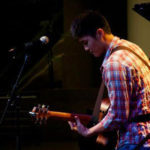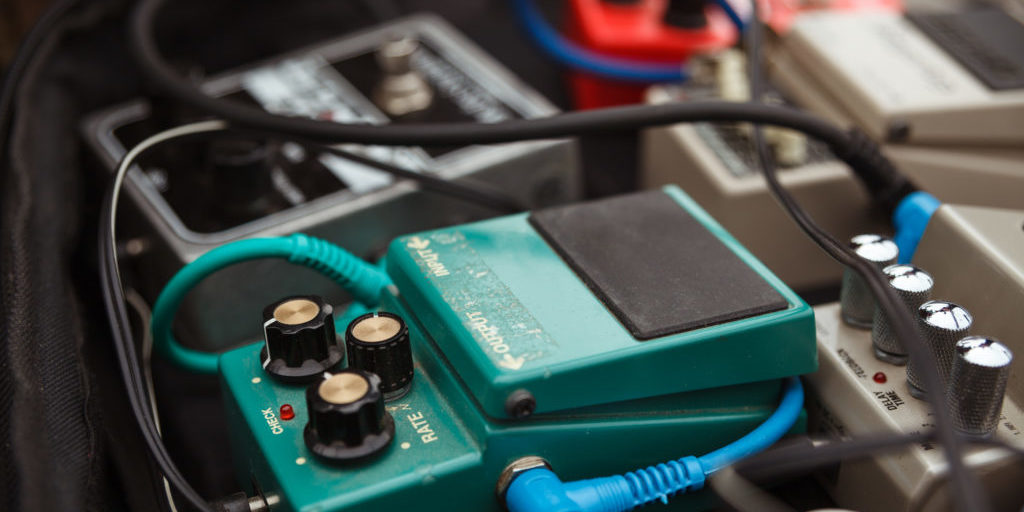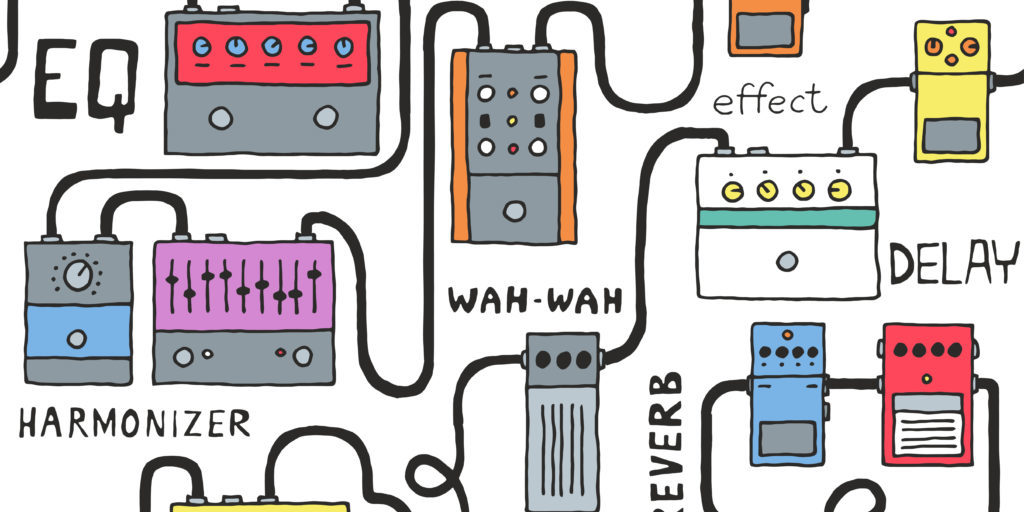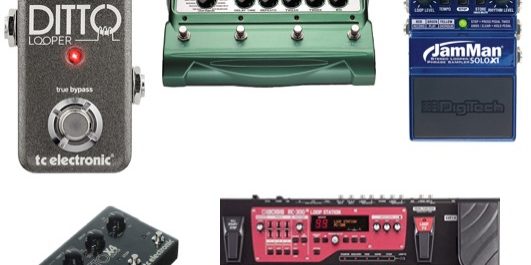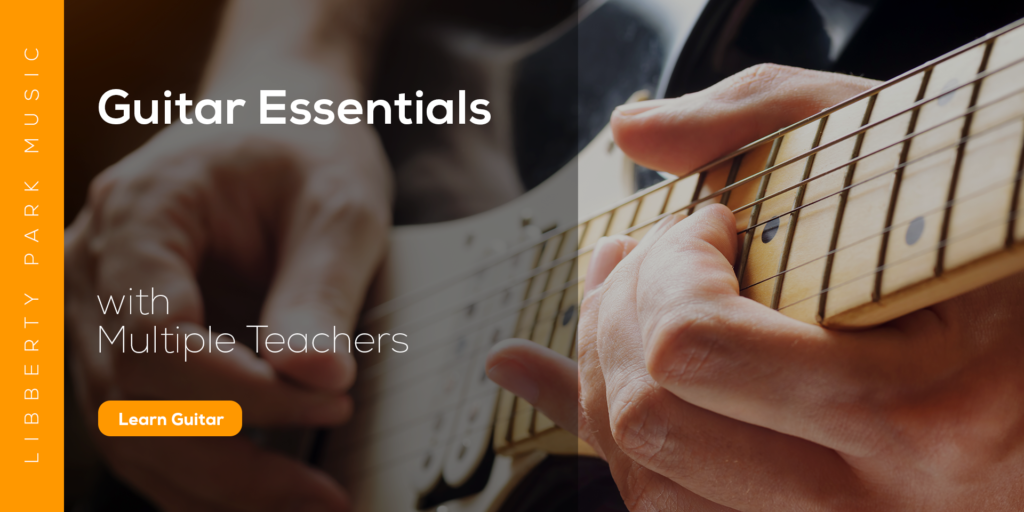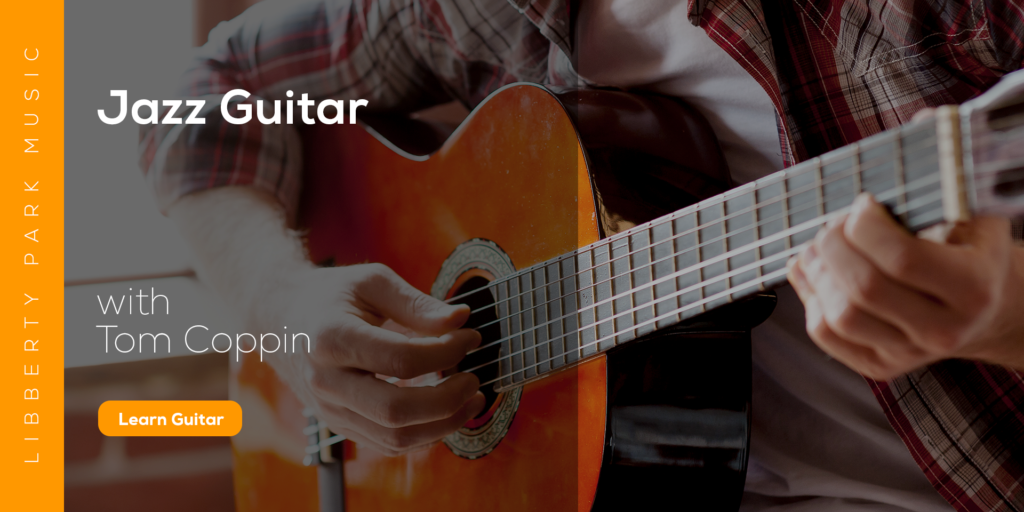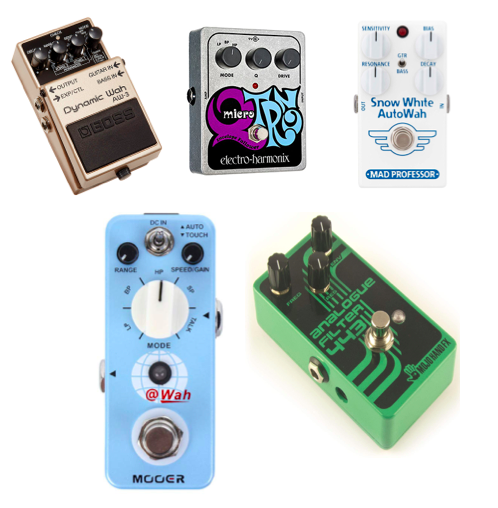
The Auto Wah effect is like the lazy younger brother of the standard Wah Wah. First of all, Auto Wah pedals come in much smaller casings than a Wah Wah pedal, and second, Auto Wahs don’t require any additional control with your foot, hence the name: Auto Wah.
If you’re not quite sure what a Wah Wah pedal does yet, feel free to check out our article on the most popular Wah Wah pedals currently in the market!
While the standard Wah Wah pedals’ envelope sweep is controlled with the position of the foot pedal, the Auto Wah reacts dynamically to volume changes coming into the pedal. For example, Auto Wahs react to relatively harder (and louder) strums by sweeping to the higher frequencies, while softer strums will have a subtler Wah effect. This can result in your typical funk rhythm guitar sound found in countless recordings from acts like Tower of Power, Parliament, Funkadelic, The Isley Brothers, Jimi Hendrix, and Nile Rogers. Of course, this automatic reaction to volume changes in an Auto Wah will result in slightly less control over your Wah sound, but it does come with some benefits. First of all, the electronic circuits within the Auto Wah pedal can react way faster than any human being can move their foot on a traditional Wah Wah, which can possibly open up new possibilities with your sound. The next thing is, there isn’t any additional coordination between your hands and foot needed, unlike a traditional Wah pedal. Finally, the majority of Auto Wah pedals come in a much smaller size than a standard Wah Wah. This feature can help you save valuable space on your pedal board.
Let’s clarify one thing first though. Technically, most of the Auto-Wah effect pedals we’ll be talking about are actually envelope filters. The difference between an actual Auto-Wah and an envelope filter is Auto-Wahs are timing/rhythm based effects, while envelope filters are volume triggered. For example, a real Auto-Wah may have you program the BPM of a song into the pedal, and the pedal will pulse the Wah effect along with the BPM. Envelope filters, on the other hand, are triggered by volume changes, as we just mentioned. However, these differences haven’t stopped pedal makers from calling envelope filters “Auto-Wahs,” as that’s a much more recognizable name.
While there are many benefits to using an Auto Wah, they’re generally not given as much attention as their bigger brother, the Wah Wah pedal. This can make it difficult to make an informed purchasing decision, so to help you out with that, here’s a short list of some of the most popular Auto Wah pedals currently on the market.
1. Electro-Harmonix Micro Q-Tron
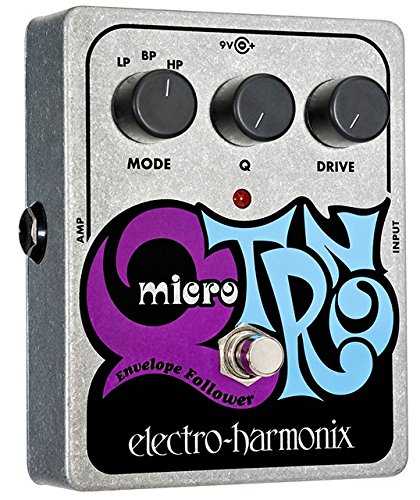
Brand New: $104.99
Used: $55 - $70
The Electro-Harmonix Q-Tron Plus may possibly be the most recognizable Auto Wah currently on the market, however, it does come in a pretty large housing. Electro-Harmonix has since dealt with this size issue by introducing the Micro Q-Tron, which is a much simpler and smaller version of the Q-Tron Plus -- perfect for those of you who are just beginning to dip your feet into the world of Auto Wahs.
The face of the pedal features three knobs labeled Mode, Q, and Drive. The Mode knob allows you to select through which frequency range the filter will pass. You can select it to emphasize low frequencies in LP (low pass) mode, mids in BP (band pass) mode, and highs in HP (high pass) mode. The Q knob adjusts the Q width of the filter. Turning the knob clockwise will cause the filter to become narrower, resulting in a more pronounced Wah effect. Check out this image to get a visual representation of a narrow Q width versus a wide Q width. Finally, the Drive knob is the sensitivity control for the pedal. The higher the setting, the more the pedal will react to your volume changes. While it may seem like there aren’t many adjustable parameters on this pedal, these three knobs alone can get you quite a wide range of sounds, making this pedal a lot more versatile than it looks.
The Micro Q-Tron comes with true bypass, and it can be powered with either a 9v battery or power adapter.
Read more here
2. Mad Professor Snow White Auto Wah
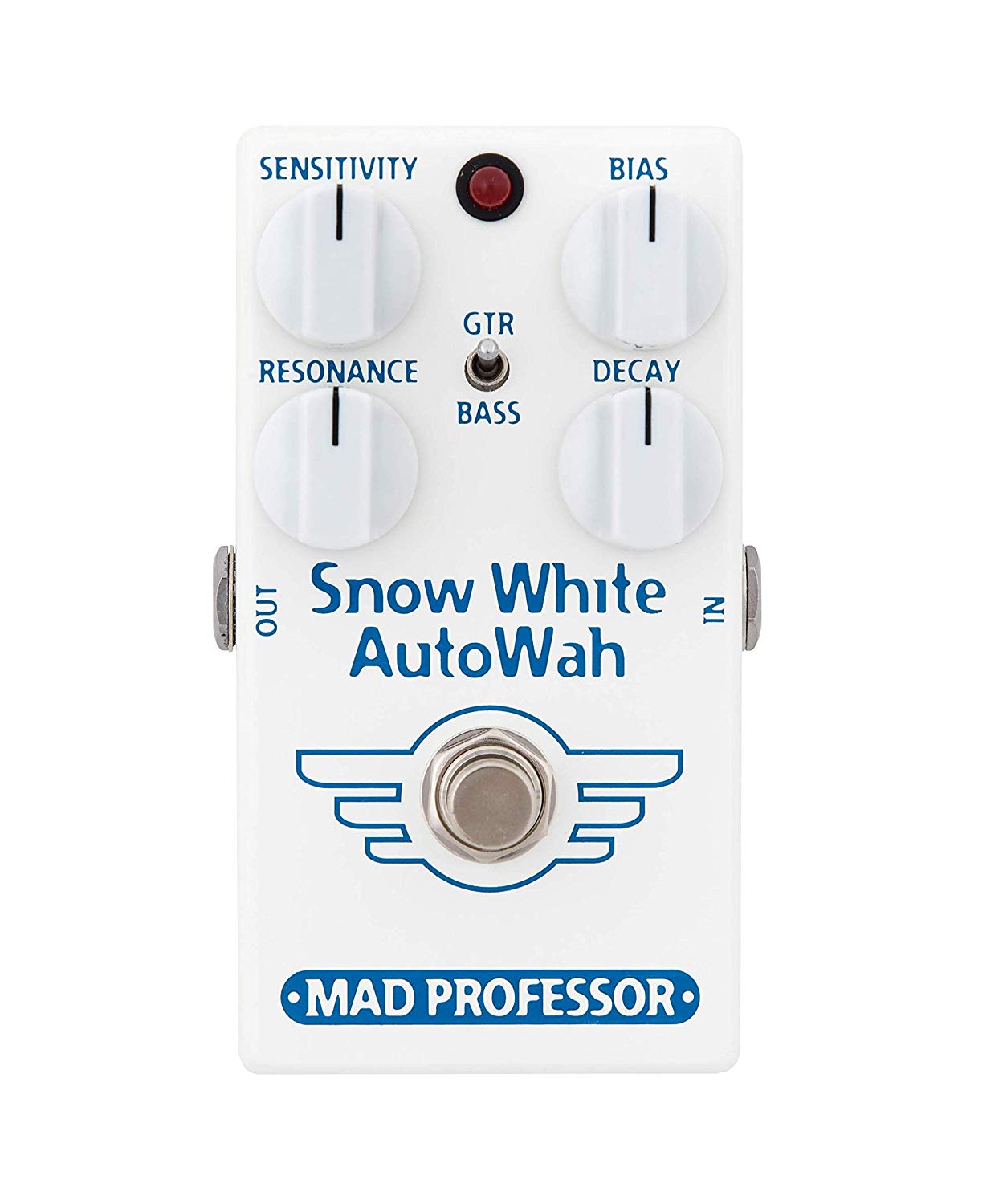
Brand New: $350
Used: $130 - $175
Here is a really popular Auto Wah pedal from Mad Professor. While the price for a new unit may seem a little outrageous, many guitarists swear by the tone you can achieve from this pedal. Scour online guitar forums long enough and you will come to realize that many people consider the Snow White to have the most accurate representation of a Wah pedal. Whether that justifies the price or not is up to you.
The Snow White Auto Wah pedal is handmade in Finland, and its circuit is based on a 1991 BJF rack mounted remote Wah circuit. The BJF circuit was studied, then redesigned with envelope filter controls. The new circuit was then placed into the Snow White’s small and compact housing that can easily find a home on pedalboards across the globe. Speaking of the pedal’s housing, the construction and casing is solid and of high quality, perfect for those of you who like to take your pedals with you on the road.
The face of the pedal features four knobs that allow you to sculpt out your tone: Sensitivity, Bias, Resonance, and Decay. The Sensitivity knob works exactly how you’d expect; it adjusts the sensitivity of the pedal to your playing. You can adjust this knob to suit the output level of your guitar’s pickups and your playing style so that the Wah filter only engages when you intend to. A quick trick you can use to further adjust the sensitivity of the pedal is to play around with the volume knob on your guitar. Remember that Auto Wah pedals react to the volume coming into the pedal, so adjusting the volume knob on your guitar is similar to adjusting the Sensitivity knob. The Bias knob adjusts the filter resonance frequency, which means you can control the tone of the Wah effect using this knob. Resonance works similarly to the Q knob found of the Electro-Harmonix Micro Q-Tron. It simply adjusts the Q width of the filter. Decay adjusts how quickly the effect falls back to its initial resting point. If you’d like the pedal to effect every note that is played, turn the Decay up (clockwise) for a faster Wah effect. Alternatively, you can slow down the decay for a more traditional Wah effect.
If you look around long enough, you may be able to find a factory produced version of this pedal instead of the hand-wired ones. While it’s cool to have handmade things once in awhile, I can’t imagine how the factory produced version of the Snow White will have any sonic differences. Additionally, the factory produced version of this pedal is significantly cheaper.
This pedal comes with true bypass, and it can be powered with either a 9v battery or power adapter.
Read more here
3. BOSS AW-3 Dynamic Wah
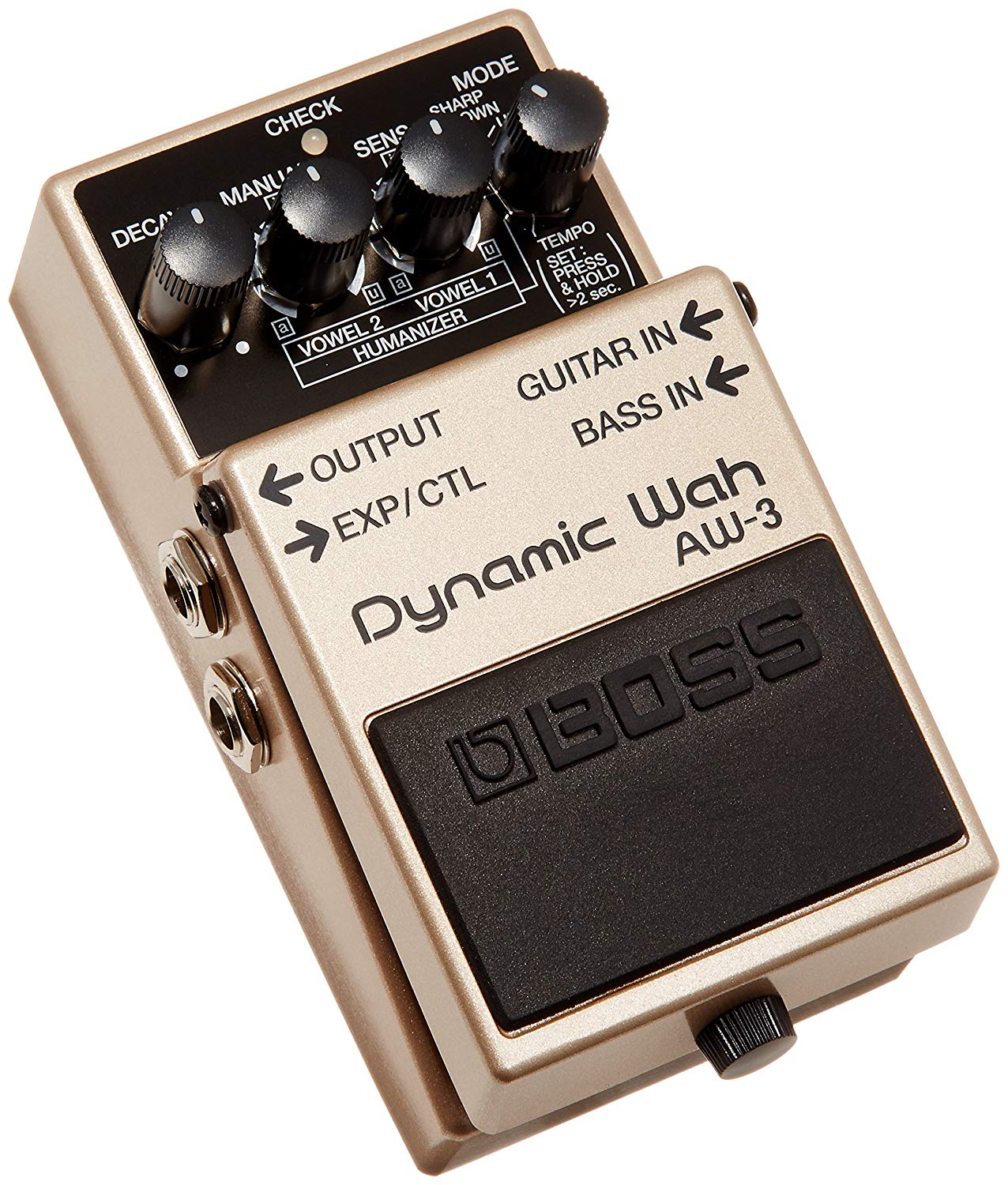
Brand New: $129.99
Used: $45 - $65
If you’ve been following our series of articles on guitar pedals, you’ll know by now that no list is complete without an addition of a BOSS pedal. While BOSS pedals may not look as fancy as some of the boutique pedals, they always come in a very durable pedal casing, and tonally speaking, they often stack up pretty well with their competitors. The AW-3 Dynamic Wah is no different, and it does come with some additional features not found on the other pedals on this list.
One of the first things you’ll notice is that this pedal has inputs for both a guitar and a bass, and it also has an input for an expression pedal. What this means is you can connect an expression pedal to the AW-3 and use the pedal as a regular Wah Wah pedal. The pedal also comes with a “humanizer” feature which alters the Wah sound to make it sound more like vowels being spoken by a human voice.
Additionally, with the Mode knob, you can program the pedal to pulse the Wah effect along with the tempo of a song, which makes the AW-3 one of the only pedals on this list to have the ability to behave like an actual Auto-Wah, instead of an envelope filter. Setting the tempo is as easy as tapping the rhythm of the song onto the pedal’s footswitch. Of course, if you’d like the pedal to react to volume changes instead (like an envelope filter), that can be set too using the Mode knob.
The knobs on the pedal are also pretty easy to understand, although they may look intimidating at first. There are four knobs that you can play around with and they are labeled: Decay, Manual, Sens, and Mode. Mode allows you to select the way the pedal will behave. There are five options available: Up, Down, Sharp, Humanizer, and Tempo. When the Mode is set to “Up,” the Wah will sweep up into the higher frequencies. In “Down” mode, the Wah will sweep down into lower frequencies. In “Sharp” mode, the Wah effect becomes more pronounced, and it’s shifted to even higher frequencies. I’m not 100% behind the “Sharp” mode as I feel like it sounds a little too harsh for my tastes, but some of you may find a use for it. When the Mode knob is set to “Humanizer,” the pedal will add vowel sounds to the Wah effect, making it sound more human. Lastly, in “Tempo” mode, the Wah effect will follow along with a set tempo that you program in.
The Decay knob works like any other Decay knob on an Auto Wah. It sets the time it takes for the Wah effect to kick in and fade away. The Manual knob adjusts the frequency where the Wah effect begins, but when the mode is set to “Humanizer,” the manual knob is used to select the first vowel sound. The Sens knob adjusts the sensitivity of the pedal to volume changes, which is similar to the Sensitivity knob in the Mad Professor Snow White. When the Mode is set to “Humanizer,” the Sens knob is used to set the second vowel sound.
As you can see, for the price, this pedal does offer quite a number of features not found on other Auto-Wahs.
This pedal, like all other BOSS pedals, does not come with true bypass. The pedal can be powered with either a 9v battery or power adapter.
Buy here
Learn with LPM
If you are looking to feel comfortable with playing basic major and minor chords, power chords, and apply different strumming techniques to your practices with Ze, check out his course called Rhythm Guitar
4. Mojo Hand FX Analogue Filter 443
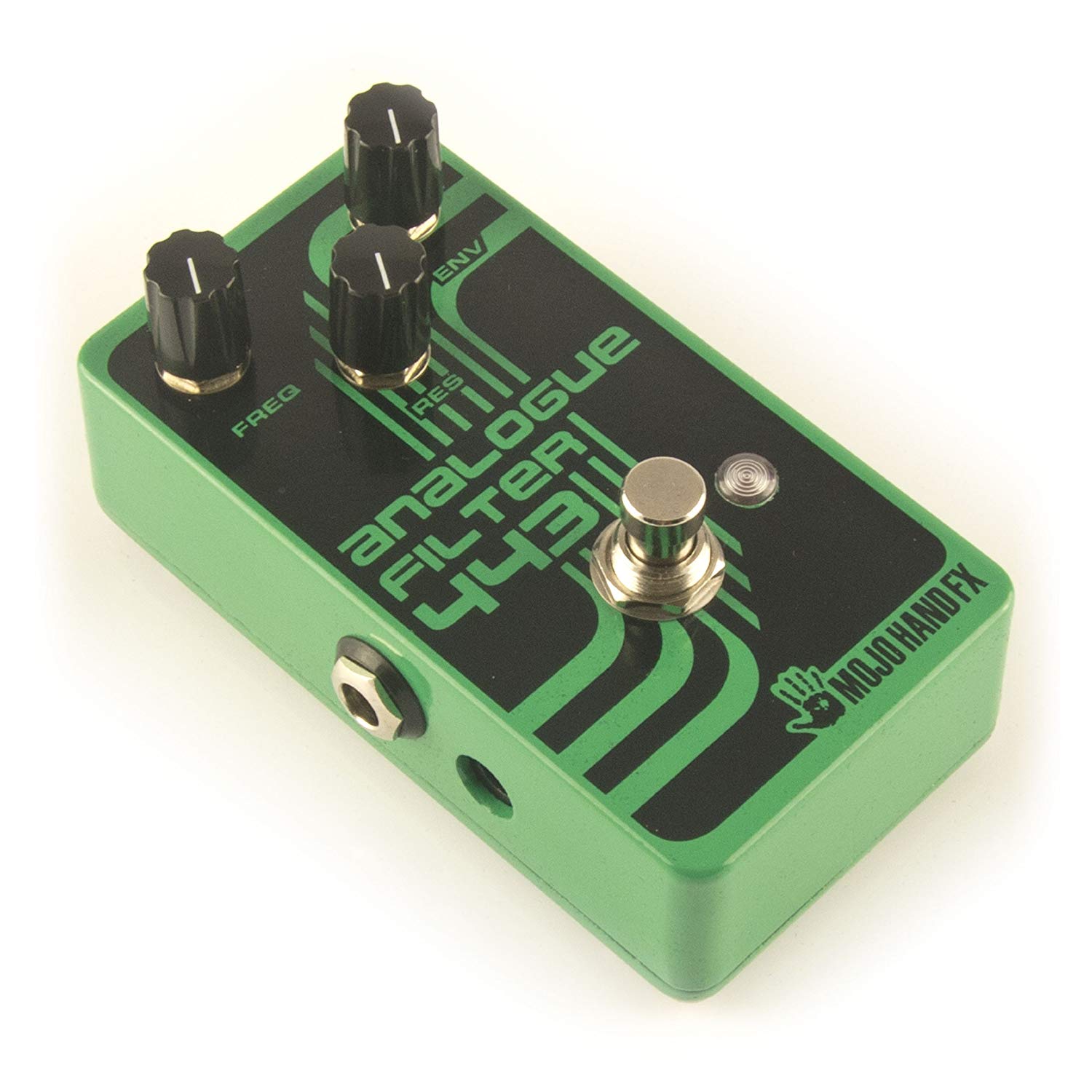
Brand New: $179
Used: $60 - $100
This pedal may not be the easiest to find on the market, but I feel like for its price, it is one of the best sounding Auto-Wahs out there. It is very easy to use, and getting a good tone out of it doesn’t require a lot of time.
The pedal has all analog components, resulting in a warm and lush Wah sound, regardless of the settings on the pedal. To be honest, the reason why I like this pedal is because its Wah tone is tuned to be a little heavier on the bass side. I find that many Wah and Auto-Wah pedals are often tuned too high for my tastes, so this pedal is quite a breath of fresh air.
The face of the pedal features only three knobs labeled: FRQ, RES, and ENV. The FRQ knob is actually a Frequency knob that adjusts which frequency the Wah effect begins at, the RES knob is a Resonance knob that adjusts the Q width of the filter, and ENV (which stands for envelope) adjusts the sensitivity of the pedal to your volume changes.
The casing of the pedal is very sturdy and durable, and there are a couple of designs for the faceplate. Of course, different designs will come with different prices, but at the end of the day, they all come with that great warm tone.
This pedal comes with true bypass, and it can be powered with either a 9v battery or power adapter.
Buy here
5. Mooer @Wah Digital Auto Wah
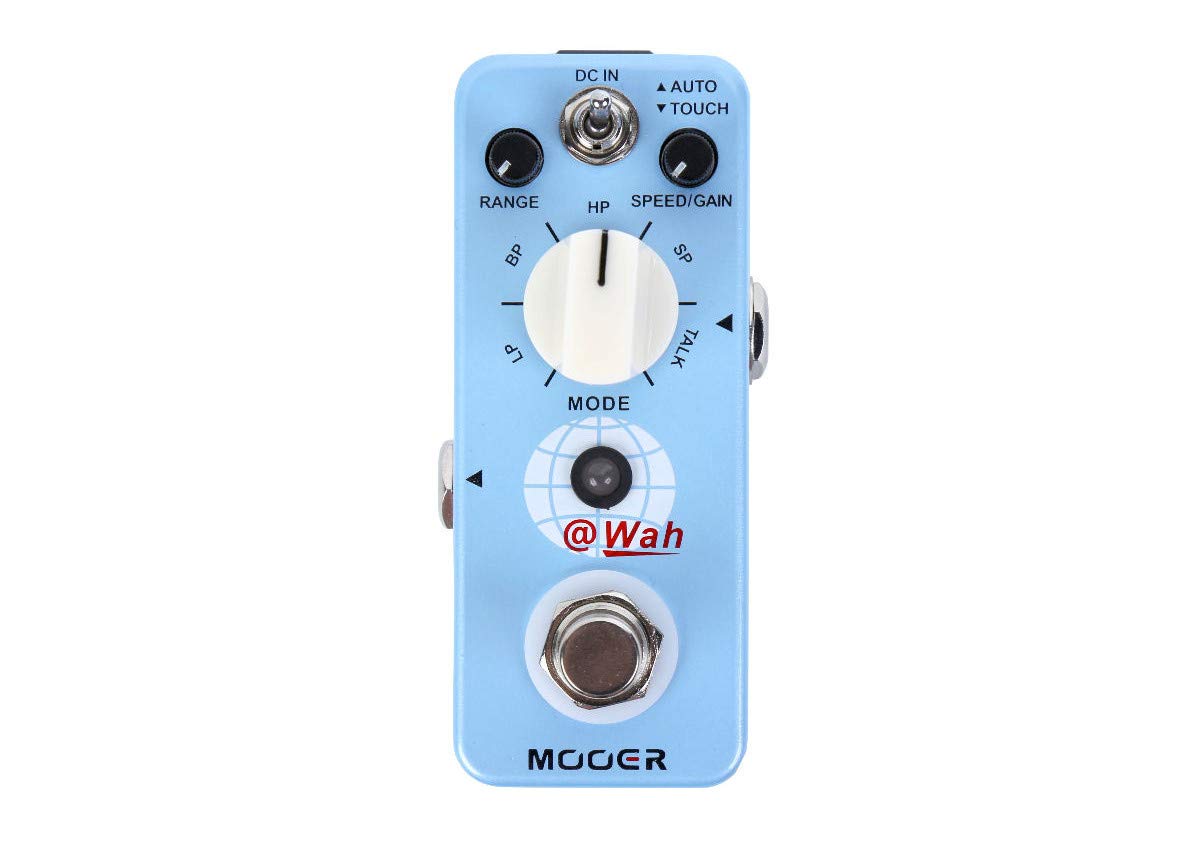
Brand New: $88
Used: $30 - $50
Here is a really affordable Auto Wah pedal for those of you who are on a tight budget, or if you’re just looking to dip your feet into the world of Auto Wahs. This micro-sized pedal is manufactured by Chinese maker Mooer, and even though Chinese guitar pedal brands don’t often have the best reputations, I have to say that Mooer pedals come with pretty good quality components, and they are really durable. I used to have a tiny pedal board filled with micro pedals from Mooer, and all of them stood the test of time. I eventually got rid of my tiny pedal board as I was looking for better sounding pedals, and while Mooer pedals do sound good, the low price point and small size does come with restrictions. It’s a typical case of getting what you pay for. However, these pedals are perfect for those of you who want to play around with different effects without breaking the bank.
The @Wah pedal is actually pretty amazing considering the number of features it has despite its size. The tiny silver switch at the top of the pedal allows the pedal to be either a time-based Auto Wah, or a volume based envelope filter. This is similar to the BOSS AW-3. Besides that, the @Wah comes with five different envelope modes. This can be selected using the big Mode knob in the middle of the pedal. The five modes provided are: LP (low pass), BP (band pass), HP (high pass), SP (standard), and Talk. LP, BP, HP, and SP, will give you Wah sounds that emphasize different frequencies, depending on which setting is used. The Talk mode is similar to the Humanizer mode found on the BOSS AW-3, just that the Mooer @Wah has less controls over the effect.
Besides the silver switch and Mode knob, there are two additional black knobs for adjusting the Range and Gain. The Range knob allows you to adjust the frequency that the Wah effect emphasizes, and the Gain knob allows you to control the amount of volume going into the pedal. It is similar to the Sensitivity knobs found on several of the other pedals on this list.
As you can see, this pedal isn’t short on features, despite its size. Additionally, the Wah sound you can get from it is pretty decent too. The pedal also features true bypass, and it can be powered using a 9v power adapter. Unfortunately, due to its size, the pedal can’t be powered using a 9v battery.
Read more here
That’s it for our list of popular Auto-Wah pedals! Is there a pedal that you feel should be on this list too? If there is, let us know in the comments section!
About the Author: Ze
Ze first began his journey playing original music and top 40s pop tunes around the country's popular venues. Eventually, through the music of John Mayer, he found a strong attraction to blues music. Ze has years of experience teaching beginners and intermediate guitarists. Currently with Liberty Park Music he is teaching Introduction to Guitar Playing for Complete Beginners, Rhythm Guitar to learn about strumming, chords and more, Guitar Essentials as a fast-track review course, and lots of Song Lessons on pop and rock hits.

